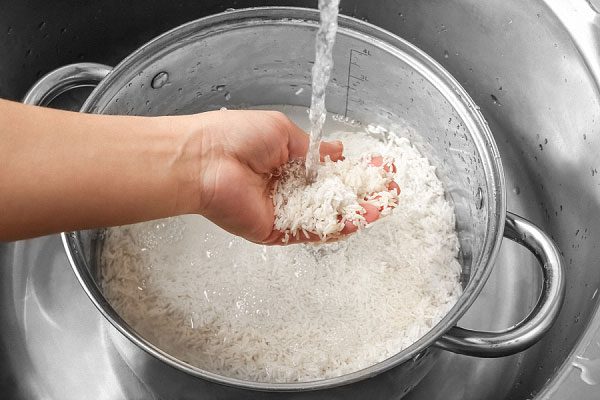Brown rice and white rice both contain significant amounts of calcium, vitamins, and minerals. However, excessive washing or milling, along with improper storage, can lead to nutrient loss.
Traditional healer Bùi Đắc Sáng from the Vietnam Academy of Science and Technology and the Vietnam Traditional Medicine Association explains that white rice is the common rice (both regular and glutinous rice) that we cook daily, but it has had the outer bran layer milled away, leaving only the white rice core. White rice is rich in essential nutrients such as magnesium, vitamins, iron, calcium, protein, and carbohydrates, making it a primary energy source in the Vietnamese diet.

Rice that is washed too thoroughly or with too much water loses many nutrients.
Brown rice retains more nutrients because it has not undergone milling. One cup of cooked brown rice contains 84 mg of magnesium, while white rice only has 19 mg. The bran layer of brown rice also contains a special oil that helps regulate blood pressure, reduce bad cholesterol, and prevent cardiovascular diseases, although consuming too much can lead to digestive issues.
According to the traditional healer, both brown and white rice are nutrient-rich, and the choice should depend on individual needs. However, the milling process results in the loss of 77% of vitamin B3, 80% of vitamin B1, 90% of vitamin B6, half of the manganese, and most of the fiber.
In agreement, Dr. Nguyễn Thùy Linh, Head of the Nutrition and Dietetics Department at Hanoi Medical University Hospital, states that the nutritional value of rice varies depending on the variety, soil conditions, climate, and cultivation practices. Improper storage, processing, and usage can also lead to nutrient depletion in rice.
“In particular, the milling, storage, and cooking processes can significantly reduce the nutritional value of rice, especially the vitamins,” the doctor said.
For instance, the protein content in rice is around 7-8%, varying depending on the degree of milling; the whiter the rice, the lower the protein content. Albumin and globulin are the main components of rice protein. While the protein content in rice is lower than that in wheat and corn, its biological value is higher.
Additionally, washing rice too thoroughly or using too much water can lead to significant nutrient loss. Numerous studies have shown that symptoms of vitamin B1 deficiency are not only common in regions consuming water-saturated rice for extended periods but also in places using other high-milled cereal flours. Therefore, rice should not be milled too finely. When washing rice, avoid vigorous rubbing; simply rinse and gently stir to remove dirt and impurities.
It is advisable to use boiling water to cook rice instead of cold water. In the case of cooking rice on a gas stove, once the rice boils, reduce the heat and cover the pot to retain heat, avoiding exposure to air that can further destroy the vitamins in the rice.
Rice stored for long periods is prone to mold due to the production of aflatoxins, which can lead to health issues over time. To store rice properly, keep it in a plastic bag and tightly seal it after taking out the rice. The storage area should be cool, well-ventilated, and not damp. Families should regularly monitor their rice supplies to prevent mold and spoilage, ensuring the health of all household members.



















































